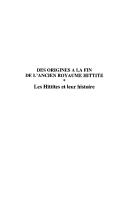| Listing 1 - 6 of 6 |
Sort by
|
Book
ISBN: 9783447058858 Year: 2009 Volume: 27 Publisher: Wiesbaden Harrassowitz
Abstract | Keywords | Export | Availability | Bookmark
 Loading...
Loading...Choose an application
- Reference Manager
- EndNote
- RefWorks (Direct export to RefWorks)
Gods, Anatolian --- Hittites --- Anatolian gods --- Religion --- Asie mineure --- Dieux anatoliens --- Religion hittite --- Histoire religieuse --- Antiquité

ISBN: 9782296027442 9782296043923 9782296068124 9782296105294 2296105297 Year: 2007 Volume: 14 3 Publisher: Paris : Harmattan,
Abstract | Keywords | Export | Availability | Bookmark
 Loading...
Loading...Choose an application
- Reference Manager
- EndNote
- RefWorks (Direct export to RefWorks)
Hittites --- Turkey --- Turquie --- Civilization --- Civilisation --- Ancient history - Anatoly. --- Religion hittite --- Asie mineure --- Rois et souverains --- Jusqu'à 546 av. J.-C.
Book
Year: 1980 Publisher: Louvain-la-Neuve : Centre d'histoire des religions,
Abstract | Keywords | Export | Availability | Bookmark
 Loading...
Loading...Choose an application
- Reference Manager
- EndNote
- RefWorks (Direct export to RefWorks)
Gebeden. --- Hettieten. --- Hittite (langue) --- Hittite (langue). --- Hittite language --- Hittites --- Hittites --- Hymnen. --- Hymnes --- Hymns --- Religion hittite. --- Textes. --- Livres de prières et dévotions. --- Religion. --- Hittites. --- Hittite.
Book
Year: 1958 Publisher: Berlin : Akademie-Verlag,
Abstract | Keywords | Export | Availability | Bookmark
 Loading...
Loading...Choose an application
- Reference Manager
- EndNote
- RefWorks (Direct export to RefWorks)
Hethiter. --- Hittite (langue) --- Hittite language --- Hittite language. --- Hittites --- Hittites --- Hittites --- Hittites --- Hittites --- Quelle. --- Religion hittite. --- Totenkult. --- Textes. --- Funeral customs and rites. --- Funeral customs and rites. --- Religion. --- Religion. --- Rites et cérémonies funéraires. --- Hethiter.
Book
ISBN: 9782204110693 2204110698 Year: 2016 Volume: 21 Publisher: Paris : ©2016 Les Éditions du Cerf,
Abstract | Keywords | Export | Availability | Bookmark
 Loading...
Loading...Choose an application
- Reference Manager
- EndNote
- RefWorks (Direct export to RefWorks)
Recueil de textes religieux des Hittites, peuple ayant vécu en Anatolie du XVIIe au début du XIIe siècle av. J.-C. Ils présentent leurs rites, leurs mythes, leurs fêtes religieuses, etc. Témoins de la vie quotidienne de cette civilisation, leurs croyances et leurs pratiques religieuses préfigurent les mythologies grecque et égyptienne. ©Electre 2016
Hittites --- Mythology, Hittite --- Mythologie hittite --- Religion --- Rites and ceremonies --- Rites et cérémonies --- Religion hittite. --- Mythologie hittite. --- 939.455 --- 891.987 --- Religion. --- Geschiedenis van de Hittieten --- Hittitische literatuur --- 891.987 Hittitische literatuur --- 939.455 Geschiedenis van de Hittieten --- Rites et cérémonies
Book
ISBN: 1575068931 9781575068930 9781575062808 1575062801 Year: 2014 Publisher: Winona Lake, Indiana
Abstract | Keywords | Export | Availability | Bookmark
 Loading...
Loading...Choose an application
- Reference Manager
- EndNote
- RefWorks (Direct export to RefWorks)
Hittite culture of the second millennium B.C.E. was strongly influenced by Mesopotamian culture, in part through the mediation of the peripheral cuneiform civilizations of northern Syria, in part through direct contact with Babylonia and Assyria. The text edited here (CTH 718) presents an extreme example of this cultural impact, featuring incantations in the Akkadian language (Hittite babilili) embedded within a ceremony set forth in the Hittite tongue. This ritual program has therefore become known to scholars as the "babilili-ritual." With almost 400 preserved lines, this ceremony is one of the longest religious compositions recovered from the Hittite capital, and there are indications that a significant additional portion has been lost. The divine figure to whom the rite is addressed is Pirinkir, a variety of the well-known Ishtar of Mesopotamia. Its purpose seems to be the elimination of the sins of a member of the royal family. Many of the ritual activities and offering materials employed here are characteristic of the cult practice of the Classical Cilician region known as Kizzuwatna, which was introduced into the central Hittite realm during the final two centuries of the state's existence. Nonetheless, the Akkadian of the incantations is neither the Akkadian employed in the Hurrian-influenced area of Syria and eastern Anatolia nor that otherwise known from the Hittite royal archives; rather, it is closer to the language of the later Old Babylonian period, even if no precise Mesopotamian forerunners can yet be identified.
Hittites --- Akkadian language --- Religion. --- Kizzuwatna (Cilicia) --- Akkadian language. --- Akkadien (langue) --- Religion hittite. --- Accadian language --- Assyrian language --- Assyro-Babylonian language --- Babylonian language --- Semitic languages --- Religion, Primitive --- Atheism --- Irreligion --- Religions --- Theology --- Textes. --- Texts. --- Kizzuwatna (royaume) --- Histoire --- Sources. --- Mythologie hittite --- Temples hittites --- Dieux hittites --- Accadien (langue) --- Assyrien (langue) --- Assyro-babylonien (langue) --- Babylonien (langue) --- Sémitique oriental (langue) --- Akkadien --- Correspondance akkadienne --- Dictionnaires akkadiens --- Emprunts akkadiens --- Glossaires et lexiques akkadiens --- Grammaire comparée --- Hymnes akkadiens --- Incantations akkadiennes --- Incantations assyro-babyloniennes --- Inscriptions akkadiennes --- Littérature assyro-babylonienne --- Noms de personnes akkadiens --- Noms géographiques akkadiens --- Philologie akkadienne --- Langues sémitiques --- Religion --- langue) -- Vocabulaire --- Kizzuwadna (Royaume) --- Kizzuwatna (Royaume) --- Asie Mineure
| Listing 1 - 6 of 6 |
Sort by
|

 Search
Search Feedback
Feedback About
About Help
Help News
News